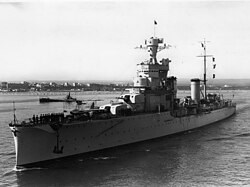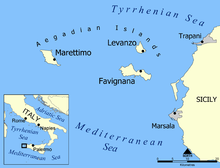Battle of Cape Bon (1941)
| Battle of Cape Bon | |||||||
|---|---|---|---|---|---|---|---|
| Part of the Second World War | |||||||
 Italian light cruiser Alberto di Giussano, c. 1930 | |||||||
| |||||||
| Belligerents | |||||||
|
|
| ||||||
| Commanders and leaders | |||||||
| Graham Stokes | Antonino Toscano † | ||||||
| Strength | |||||||
| 4th Destroyer Flotilla: 4 destroyers |
4th Cruiser Division: 2 light cruisers 1 torpedo boat | ||||||
| Casualties and losses | |||||||
| None |
817–900+ killed 2 light cruisers sunk | ||||||
The naval Battle of Cape Bon took place on 13 December 1941 during the
.Background
Regia Marina
When Italy declared war in June 1940, the Regia Marina was one of the largest navies in the world but it was restricted to operations in the Mediterranean. The British Empire possessed enough resources and naval might to maintain a strong presence in the area and replace most losses by redeploying ships. This led to caution by the Italian command and a tendency to avoid conflict.[1] Control of the Mediterranean was disputed by the Regia Marina the Royal Navy and their allies. The sea was vital for the supply of the Italian and German forces in North Africa, as well as the maintenance of Malta as a British offensive base. Without Malta, it would have been much harder for the British to intercept Italian supply convoys.[2]
Signals intelligence
The possession of radar and the breaking of Italian codes, particularly the C38 m cipher machine used by the Regia Marina, further contributed to British success.[3] In November 1941, the supply of the Axis forces in Libya from Italy had been interrupted by Force K from Malta, which had destroyed several Italian convoys, notably in the Battle of the Duisburg Convoy and the loss of nearly 70 per cent of the supplies sent to Libya, including 92 per cent of the fuel.[4] Force K and ships from Alexandria, intercepted an Axis convoy consisting of the German transports Maritza (2,910 GRT) and Procida (1,843 GRT), escorted by the Italian torpedo boats Lupo and Cassiopea, sailing from Greece to Benghazi of on 24 November. The convoy was about 100 nmi (190 km; 120 mi) west of Crete when the merchant ships were sunk by the British cruisers HMS Aurora and Penelope and the destroyers HMS Lance and Lively, the torpedo boats making off once it was certain that the ships were doomed. The loss of the cargoes led the German command to report that the fuel situation of the Luftwaffe in North Africa was desperate.[5]
Axis convoys
The Italian and German forces in North Africa, facing
Da Barbiano and Di Giussano

Da Barbiano (flagship) and Di Giussano left Taranto at 8:15 on 5 December 1941, reached Brindisi at 17:50, took on about 49 long tons (50 t) of supplies, then proceeded to Palermo on 8 December, where they loaded another 22 long tons (22 t) of
Prelude
Italian preparations
Convoy M. 41, was planned for 13 December but air cover by aircraft based in Libya would be impossible unless they received the fuel from Italy.
British plans

Four destroyers of the 4th Destroyer Flotilla consisting of the destroyers HMS Sikh (Commander G. H. Stokes), Maori, Legion and the Dutch Isaac Sweers, had departed Gibraltar on 11 December to join the Mediterranean Fleet at Alexandria.[9] By 8 December, the British had de-coded Italian C-38 m wireless signals about the Italian supply operation and its course for Tripoli. The RAF sent a Wellington bomber on a reconnaissance sortie to disguise the British source and on 12 December the 4th Destroyer Flotilla, heading eastwards towards the Italian ships, was ordered to increase speed to 30 kn (56 km/h; 35 mph) and intercept the Italian ships.[3]
In the afternoon of 12 December, a
Following new Ultra decodes a new reconnaissance aircraft spotted Toscano's ships at sunset on 12 December, after which the 4th Destroyer Flotilla was directed to intercept the two cruisers, increasing speed to 30 kn (56 km/h; 35 mph).
Battle
12/13 December, night
The 4th Destroyer Flotilla sighted the Italian cruisers near Cap Bon, at 02:30 on 13 December.[9] At 2:45 on 13 December, seven miles off Cape Bon, the Italian ships heard the noise of a British plane (a radar-equipped Vickers Wellington, which located the ships and informed Stokes about their position), and at 3:15 they altered course to 157° to pass about a mile off Cape Bon. Five minutes later, Toscano suddenly ordered full speed ahead and to alter course to 337°, reversing course; this sudden change disrupted the Italian formation, as neither Cigno (which was about two miles ahead of the cruisers) nor Di Giussano (which was following Da Barbiano in line) received the order, and while Di Giussano saw the flagship reverse course and imitated her (but remained misaligned) Cigno did not noticed the change until 3:25, when she also reversed course, but remained much behind the two cruisers.[4]
13 December, morning

Stokes's destroyers were just off Cape Bon by then and they had spotted the Italian ships. Arriving from astern, under the cover of darkness and using radar, the British ships sailed close inshore and surprised the Italians, who were further out to sea, by launching torpedoes from short range. The course reversal accelerated the approach between the two groups and the Allied destroyers attacked together; Sikh fired her guns and four torpedoes against Da Barbiano [less than 1,000 m (3,300 ft) distant], Legion did the same, Isaac Sweers opened fire against Di Giussano and Maori fired six torpedoes against Di Giussano. Toscano ordered full speed and to open fire (and ordered Di Giussano to increase speed to 30 kn (56 km/h; 35 mph). Da Barbiano also started a turn to port (on orders from Captain Giorgio Rodocanacchi) but at 3:22, before her guns were able to fire (only some machine guns managed to), the cruiser was hit by a torpedo below the foremost turret, which caused her to list to port. Da Barbiano was then raked with machine gun fire, which killed or wounded many men and set fire to the fuel barrels and was hit by a second torpedo in the engine room.[4]
At 3:26 Maori fired two torpedoes at Da Barbiano and opened fire with her guns, hitting the bridge. The cruiser was hit soon after by another torpedo in the stern (possibly launched by Legion); Di Giussano was also hit by a torpedo and gunfire, being left disabled. The land behind the Allied destroyers made it impossible for the Italians to see them and Di Giussano managed to fire only three salvoes.[4][9] In five minutes both cruisers were disabled; Da Barbiano rapidly listed to port, while fires quickly spread all over the ship and into the sea by the floating fuel; the crew abandoned ship.[4] At 3:35, Da Barbiano capsized and sank in a sea of flame, with Toscano, Rodocanacchi and another 532 men still aboard. Di Giussano was left dead in the water with fires raging; the crew struggled to keep the ship afloat but she also had to be abandoned, breaking in two and sinking at 4:20, with the loss of 283 men.[10][4]
Aftermath
Analysis
Toscano's decision to reverse course has never been fully explained and various possibilities have been suggested. He may have decided to turn back after realizing that he had been spotted by aircraft, as he did on 9 December. A course towards the Aegadian islands would have made more sense, instead of the north-westerly course ordered by Toscano. The course change was ordered more than 30 minutes after the cruisers had been spotted; Toscano may have wanted to mislead the reconnaissance aircraft about his real course, wait for it to leave and then turn again for Tripoli. He may have thought, from the aircraft noise, that
Casualties
After a brief encounter with Isaac Sweers, Cigno rescued nearly 500 survivors; others reached the coast and another 145 men were later saved by Italian MAS boats (
Footnotes
- ^ Greene & Massignani 2002, pp. 15–17.
- ^ Greene & Massignani 2002, pp. 10–11.
- ^ a b Hinsley 1994, p. 195.
- ^ a b c d e f g h i j k l Cocchia 1962, pp. 157–173.
- ^ Rohwer & Hümmelchen 2005, p. 118; Roskill 1957, p. 533.
- ^ a b Santoni 1981, pp. 130–136.
- ^ Hinsley 1994, pp. 194–195.
- ^ Cocchia 1962, pp. 157–173; Greene & Massignani 2002, p. 198; Roskill 1957, p. 534.
- ^ a b c Roskill 1957, p. 534.
- ^ a b Ghisotti 2010.
- ^ Greene & Massignani 2002, pp. 199–200.
- ^ O'Hara 2009, p. 153.
References
- Cocchia, Aldo (1962). La difesa del traffico con l'Africa Settentrionale: dal 1° ottobre 1941 al 30 settembre 1942 [The Defence of traffic with North Africa from 1 October 1941 to 30 September 1942]. Marina italiana nella seconda guerra mondiale (in Italian). Vol. VII. Roma: Ufficio Storico della Marina Militare. OCLC 221140047.
- Ghisotti, A. (21 July 2010). "Il ritrovamento del relitto dell'incrociatore italiano da Barbiano" [The Discovery of the Wreck of the Italian Cruiser Barbiano] (in Italian). Focus magazine. Retrieved 23 November 2017.
- Greene, J.; Massignani, A. (2002) [1998]. The Naval War in the Mediterranean 1940–1943 (pbk. ed.). Rochester: Chatham. ISBN 978-1-86176-190-3.
- Hinsley, F. H. (1994) [1993]. British Intelligence in the Second World War. Its influence on Strategy and Operations. History of the Second World War. abridged (2nd rev. ed.). London: ISBN 978-0-11-630961-7.
- O'Hara, Vincent P. (2009). Struggle for the Middle Sea: The Great Navies at War in the Mediterranean Theater, 1940–1945. Annapolis, Maryland: Naval Institute Press. ISBN 978-1-59114-648-3.
- Rohwer, Jürgen; Hümmelchen, Gerhard (2005) [1972]. Chronology of the War at Sea, 1939–1945: The Naval History of World War Two (3rd rev. ed.). London: Chatham. ISBN 978-1-86176-257-3.
- OCLC 881709135. Retrieved 14 March 2016.
- Santoni, Alberto (1981). Il vero traditore: il ruolo documentato di ULTRA nella guerra del Mediterraneo [The Real Traitor: The Documented Role of Ultra in the Mediterranean War]. Biblioteca del mare, 217: Guerra sui mari, 34 (in Italian). Milan: Mursia. OCLC 491163648.
Further reading
- D'Este, Carlo (1990). World War II in the Mediterranean, 1942–1945. Major Battles and Campaigns. Chapel Hill, NC: Algonquin Books. ISBN 978-0-94557-504-7.
- Smith, Peter C. (2009) [1995]. Eagle's War: Aircraft Carrier HMS Eagle 1939–1942 (2nd pbk. ed.). Manchester: Crécy Publishing. ISBN 978-0-9075795-3-3.
